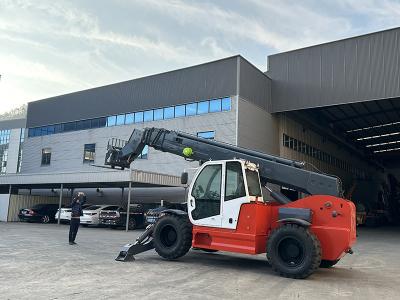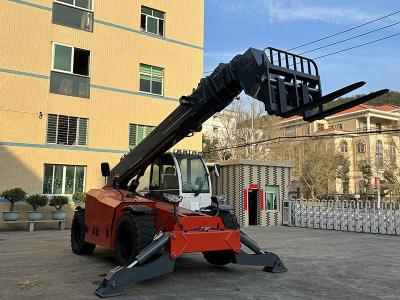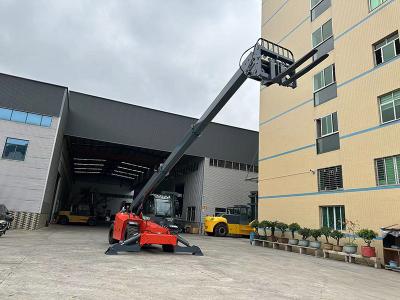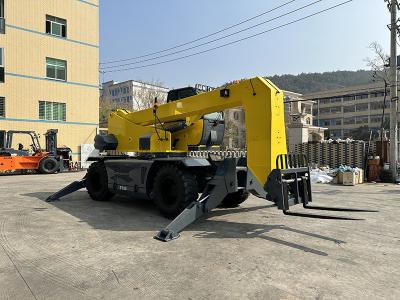I. The main causes of rough terrain forklift oil leakage
1. Poor quality, material or workmanship of forklift parts, poor structural design;
2. Improper assembly and adjustment of parts, unclean mating surfaces during assembly, damaged or displaced gaskets or failure to follow operating specifications;
3. Uneven torque of fastening nuts, thread breakage or loosening, and failure to work;
4. After long-term use, seals are worn beyond the limit, aged, deteriorated, deformed and failed;
5. Too much lubricating oil is added to the forklift, the oil level is too high or the wrong oil is added;
6. The joint surface of heavy duty forklift parts (side covers, thin-walled parts) is flexed and deformed; the shell parts are damaged, resulting in lubricating oil leakage;
7. After the vent plug and the one-way valve are blocked, the pressure difference between the inside and outside of the box shell often causes oil leakage at the weak seal.
II. Measures to prevent forklift oil leakage
1. Pay attention to the role of the gasket. Various gaskets are installed between the parts of the forklift's static parts (such as the end faces of each joint surface, each end cover, body, cover gasket, flat flange cover, etc.) to play a sealing role. Although the gasket is small, it plays a big role. If the material, size, production quality and installation method do not meet the technical specifications, it will not play a sealing role and may even cause an accident. For example, the oil pan or valve cover is not easy to compact due to the large contact area. It is easy to cause oil leakage. Oil leakage at the rear oil seal of the crankshaft will also penetrate into the clutch, which will not only waste oil, but also cause the forklift clutch plate to be contaminated, slip and burn. Therefore, when disassembling and assembling the gasket, you should pay attention to properly place it, carefully check its quality, and assemble it according to regulations.
2. Tighten each nut according to the maintenance specifications. All kinds of nuts with fastening functions on the forklift (such as cylinder head nuts, gear chamber cover nuts and valve cover nuts) should be tightened evenly according to the fixed torque. If it is too loose, the gasket will not be pressed tightly and oil will leak; if it is too tight, the metal around the screw hole will bulge or the thread will slip and cause oil leakage. In addition, if the drain plug of the oil pan (box shell) is not tightened or loosens and falls off, it is easy to cause a large amount of loss, and then a "burned shaft" machine damage accident will occur.
3. Replace the failed oil seal. There are many moving parts on the forklift with oil seals and O-rings. These parts will be improperly installed, and the journal and the oil seal edge will not be concentric, which is very easy to throw oil due to deflection. Some will lose elasticity due to rubber aging after long-term use; some will lose the oil sealing function due to lip damage or failure of the self-tightening spring. Therefore, if the rubber seal is found to be leaking oil, it should be repaired according to the standard forklift or replaced with qualified accessories.
4. Replace severely worn parts in time. When the clearance between the main bearing and the journal is too large, the front and rear oil seals will lose their sealing due to the impact of the crankshaft, causing the engine oil to leak from the crankshaft head or leak into the clutch, thereby contaminating the friction plate and causing slippage and failure.
5. Avoid blockage of one-way valve and vent valve. Regularly check, dredge and clean to keep the one-way valve and vent valve unobstructed.
6. Properly solve the sealing of various oil pipe joints. When replacing the connecting nut, you should grind the connecting joint and the horn seal or clamp the thin copper sheet between the two cones, tighten and compact the nut to ensure the seal.
7. Avoid wheel hub oil throwing. When the forklift wheel is being repaired and maintained, the forklift wheel hub bearing and cavity have too much lubricating grease, or the forklift wheel hub oil seal is improperly matched, poor quality, aging failure, and the forklift wheel hub temperature is too high due to frequent braking, and the half-axle nut is loose, which will cause the wheel hub to throw oil. Therefore, forklift maintenance should adopt the "cavity lubrication method" to lubricate appropriately, dredge the air holes, use the brakes reasonably, strictly select high-quality accessories, and assemble and adjust according to the process specifications to avoid forklift wheel hub oil throwing.




















